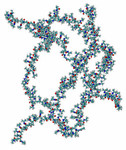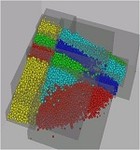Fluid Mechanics and Thermodynamics

 The researchers of the SFB 716 concentrate on the process of solving problems focused on fluid mechanical processes which are described by particle approaches. In addition to classical mechanical systems, thermodynamic systems are investigated as well.
The researchers of the SFB 716 concentrate on the process of solving problems focused on fluid mechanical processes which are described by particle approaches. In addition to classical mechanical systems, thermodynamic systems are investigated as well.
Chemical processes, medical technology as well as classical fluid mechanics
The field of application of the various sub-projects of the project area A cover chemical processes, chemical engineering, medical technology as well as classical fluid mechanics in mechanical engineering. Within the several sub-projects, simulation methods are developed in order to examine existing or new processes from different areas.
For example, porous material for ion exchange is considered which are utilized for the desalination of water, or nanoparticles for the production of nanomaterials are investigated, which are required in nanomedicine. Other examples are nanocrystals, which are already applied in the oil industry as a filter and macroscopic particles that lead to wear in hydraulic machinery.
For the corresponding simulations particle-methods are applied which usually contain millions of iDepending on the scale of the system a single particle maps an individual atom or up to a few billion atoms. The scale range covers a wide area from the nano-level as well as up to the macro-level. In doing so one challenge is to develop and improve the used methods for the application to different scales including a large number of particles.
Development and extension of existing methods and coupling approaches
In the framework of complex technical particle-simulations new methods, additional extensions to existing simulation approaches and the coupling of different particle-based simulation have to be developed. Thus it is possible to answer such complex problems numerically.
In the different areas the approaches extend from the molecular dynamics to classical continuum mechanics. The basic steps of all particle simulation are the search for adjacent particles, the interaction of neighboring particles and the integration of the particle's motion.
Large numbers of particles require parallelization and the use of supercomputers
Depending on the scale and method different approaches for determing adjacent particles, calculating forces and integrating particels are used. The simulation require huge numbers of particles. These numbers could not be handled by normal workstations. Therefore the methods are modified in such a way that they can be used with supercomputers such as CRAY X6, using different approaches for the parallelization.
Subprojects of this project area

